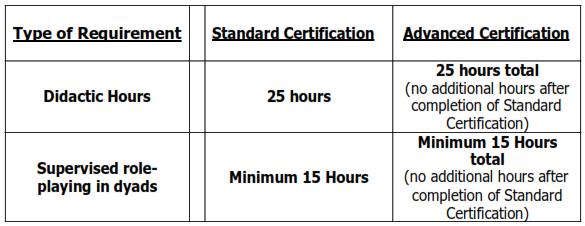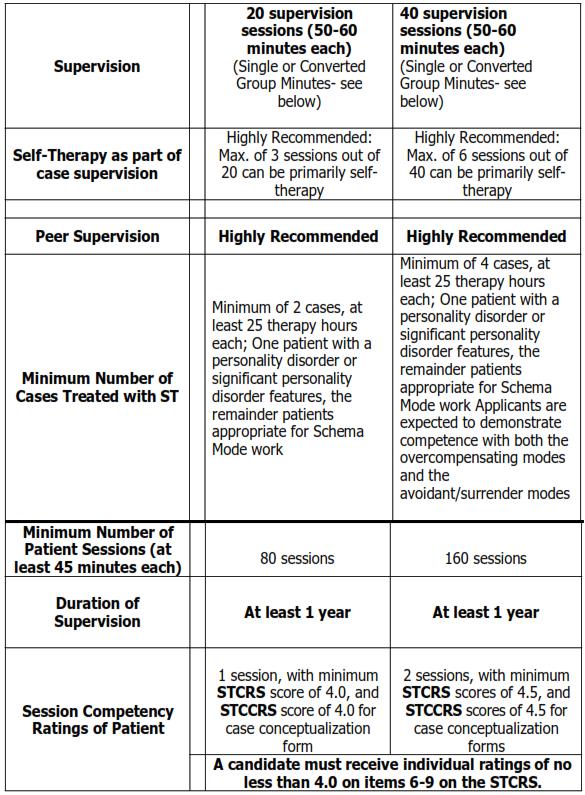2019 ISST REQUIREMENTS FOR CERTIFICATION AS A SCHEMA THERAPIST (INDIVIDUAL) Qualifications to apply for Certification for those completing training after December 31, 2014: To qualify for certification in Schema Therapy a person must fulfill the following two qualifications: 1. Academic training: Hold at least a master's degree in psychology, clinical social work, psychiatric nursing or a counseling area that leads to licensing; or a medical degree with psychiatric residency (or residency equivalent if it is defined differently in that country). 2. License or certification for practice: In countries that certify or license the above professions, a person must be certified or licensed by either the government body or professional organization which grants this. If no such control exists in a country, the standard of one of the national or international professional psychotherapy organizations must be met to fulfill this requirement. If you belong to another group that is licensed or certified to practice psychotherapy in your country, please submit this information with your academic qualifications to be considered for certification application. Some countries have described in detail how the ISST qualifications need to be applied for their country. The UK is one example of this and for exception requests these standards are used. 2019 ISST Minimum Certification Training Requirements (To understand this chart, please be sure to read the explanations below the table.) 
Important Explanations & Notes Explanation of the 2 Certification Levels 1. Standard International Certification: Therapists at this level are certified to practice schema therapy, participate in outcome studies, and to train or supervise other therapists at a basic level only with the supervision of an Advanced level Trainer-supervisor within an approved training program. They are not qualified to run a training program, rate sessions, or offer supervision on difficult cases. 2. Advanced International Certification: Certified to treat all patients, participate in outcome studies, and to apply for certification as a supervisor/trainer/rate others, and to run training programs after three years of practice as a certified schema therapist.. Each country can decide which of these 2 levels of training it wants to offer (including other non-certification courses). APPROVED CERTIFICATION TRAINING The only type of workshop or training that ISST is involved in approving or providing attendance certificates for are those given as part of the approved curriculum of the ISST Approved Certification Training Program by ISST Certified Trainers affiliated with that program. All other training, even if about ST and/or given by Certified ISST Trainers, do not count toward ISST certification. Workshops on ST by ISST certified ST trainers given outside of the certification curriculum can only count toward the continuing education requirement recently added to maintain certification as a Schema Therapist. There are currently two ways to meet the Training Requirement for ISST Certification: 1. Attend an approved ISST ST Training program in its entirety. For example, the ISST approved International ST Training Program from the ST Institute of NY & NJ. In this case the program is responsible to see that all parts of the ISST Certification curriculum are covered in your training. 2. Assemble your own certification training program by independent study. In this option you would need to carefully combine trainings from the various ISST Approved Certification programs to meet all of the ISST Certification required curriculum. In addition, you would need to submit the specific certificates of training modules from those trainings. In some countries – e.g., Germany – this can be done rather easily as a shared curriculum and workshop plan are used. In other places this may be more complicated. It is your responsibility when applying by Independent Study to procure all of the needed certificates and send scans of them to the ISST Coordinator of Training & Certification. a. For the independent study programs only workshops given by Certified Trainers who are part of an ISST Approved Training Programs or have been invited by an approved program to provide a particular module of the ISST certification curriculum can be counted toward the 25 hours required for certification. In addition, they must provide you with the module certificate form that lists the curriculum components covered and the number of trainees present. This certificate must also have the signatures of the certified trainer providing the training and the director of the ISST Approved certification program that sponsored the training. Training Programs Content Curriculum for the 25 Required Didactic Training Hours: 1 Concept and Case conceptualization 1.1 Schema Theory and Concept
1.2 Treatment Formulation & Case Conceptualization
2. Therapy Relationship
3 Schema Therapy techniques 3.1 Cognitive techniques
3.2 Experiential techniques I (Imagery work)
3.3 Experiential techniques II (e.g. Mode dialogues & Roleplay)
3.4 Homework assignments and behavior change strategies 4 Specific Treatment Populations 4.1 Schema Mode Work with Personality disorders
4.4 Schema Therapy with other Axis-I-Disorders (optional until an evidence base is established)
5 Literature
Curriculum for the 15 Required Dyadic Training hours: 1. Whole group or “fishbowl” exercises are encouraged and can count towards as much as 2 hours of the dyadic requirement, as long as the whole group is participating in the practice. Whole group exercises can be a great way to demonstrate strategies in preparation for the dyadic practice. 2. Dyadic Practice: Therapists pair up and take turns (approximately 30 minutes each direction) in the role of patient and therapist. If the group is large, and supervisors are scarce, a third person may act as the observer/coach. But - the observer should only be in that role one time so as to maximize practice opportunity. 3. Dyadic practice exercises must include: Limited Re-Parenting with Child modes, especially with the Vulnerable and Angry Child Modes, Confronting the Detached Protector Mode, Confronting the Punitive (Demanding) Parent Modes, the Use of Empathic Confrontation, Imagery, Limit Setting, and Therapy Relationship work. 4. Therapists Schemas: Dealing with obstacles in treatment when therapists’ schemas become activated with certain types of patients. Trainer/participant Ratio 1. Only 6 hours of training in a group of more than 40 can be counted toward the didactic component (only) of certification training. 2. A minimum of 1 trainer for every 20 participants (optimally 1 trainer for every 10 participants) is required in the dyadic role-play portion of the training. We know this is challenging in some countries where the number of available advanced schema therapists is still growing. In these cases, offering separate consecutive dates for smaller group training to cover the dyadic role play might help meet this requirement. It is one of the most important aspects of the training program for learning the model, in addition to personal and group supervision, and therefore requires that advanced schema therapy supervisors be available to guide and coach the dyadic practice exercises. Supervision Requirements 20 Hours for Standard level certification (in some programs: supervisors view an additional 2 hours of taped sessions) 40 Hours for Advanced level certification (in some programs: supervisors view an additional 4 hours of taped sessions) In some programs (New York/New Jersey, for example) 2- 4 additional taped sessions are submitted to supervisors, rated, and discussed throughout the supervision period. In this case, supervisors view taped sessions prior to supervision session. (The supervisor’s “viewing” of tapes, prior to session, is not included in the total number of supervision hours required) Content of Supervision
Converting Group Supervision Hours to Individual Supervision Hours We have worked out a (complicated) system for converting group supervision hours into individual supervision hours (applies to supervision groups with 2 to 6 members). The basis of the conversion is that we voted to consider 3 group hours (180 minutes) with 6 members in the group, to be approximately equivalent to 1 individual supervision “hour” (50 minutes). For example, if a group has 6 trainees, then we assume that each group member gets 1/6 of the group time. Thus, if the group is 2 hours long (120 minutes), then each member gets 20 minutes of direct supervision time in the group. This is equivalent to 20 minutes of individual supervision time. The remaining 100 minutes is spent observing the supervision of other group members. We have decided (by voting) that the time spent observing supervision of another member is equivalent to 20% of the time spent receiving supervision on one’s own cases. Thus the 100 minutes observing others is equal to 20 individual supervision minutes (20%). Using this formula, the chart below allows you to compute the number of supervision credits for each size of group. For each 60 minutes of group supervision time:
Note that, to be certified, trainees may receive a combination of group and individual supervision. Individual supervision is recommended, but not mandatory. Patient Session Recording Ratings Final Required Tape Ratings 1. For a standard certification the tape must show a patient who is appropriate for Schema Mode work due to complication, chronicity, failure to respond to treatment or relapse. For an advanced certification One patient with a personality disorder or significant personality disorder features and one who is appropriate for Schema Mode work due to complication, chronicity, failure to respond to treatment or relapse. Applicants are expected to demonstrate competence with both the overcompensating modes and the avoidant/surrender modes. 2. The two required tapes for Advanced certification must be scored by two different raters and be from 2 different patients. Access to Independent raters will normally be arranged by the site offering the training program. 3. Definition of “independent rater” for the STCRS ratings required for certification. In the ISST Executive Board Meeting 5-28-2013 a clarification of the independent rater was defined as being an ISST certified Supervisor/trainer who is not the director of the applicants training program, a supervisor or a trainer – didactic or role-play portions. We realize that there will be situations where this definition cannot be met completely – for example, a country with only one training program or very limited number of certified supervisor/trainers, forensic settings with limitations regarding taping or the removal of tapes from the institution. In those situations, please write to the ISST training coordinator to request an exemption. We took this position to remove the possibility of naturally occurring bias when the trainer and independent rater roles overlap. 4. The STCRS is still a pilot scale, as are the cut-off scores. We expect to refine the STCRS and cut-off scores over the next 1 or 2 years based on research data. We are also in the process of having the STCRS validated empirically and establishing an inter-rater reliability standard for independent raters to meet. 5. In addition to the required 4.0 (standard) and 4.5 (advanced) minimum required score – a candidate must receive individual ratings of no less than 4.0 on items 6-9 on the STCRS. 6. Video recording is strongly preferred to audio only. (Revised by Joan Farrell to include clarifications approved by the ISST Executive Board in 2016 and by Paul Kasyanik to include clarifications approved by the ISST Executive Board in 2018) |
